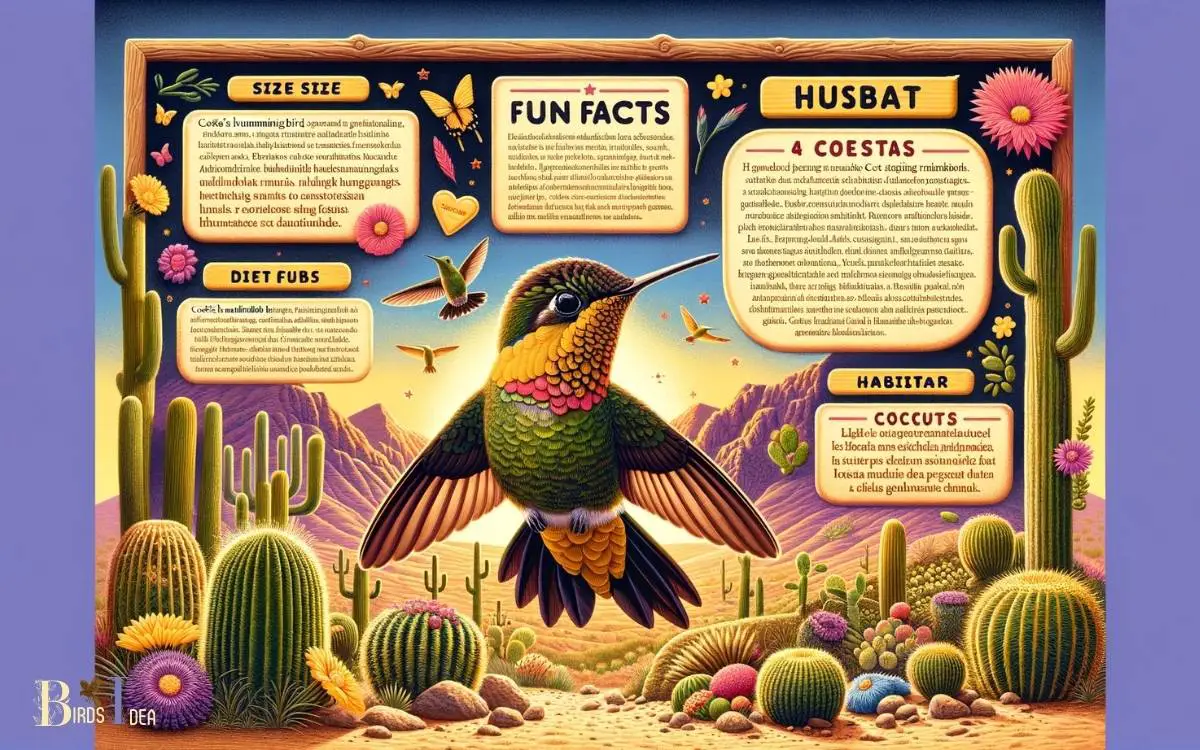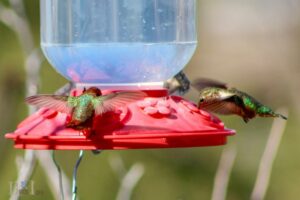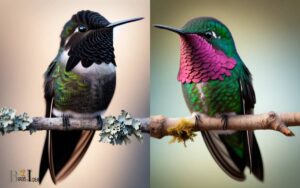Costa’s Hummingbird Fun Facts: Iridescence!
Costa’s Hummingbird (Calypte costae) is a small bird known for its vibrant color and remarkable agility.
Males have an iridescent purple crown and throat, while females have a more subdued appearance.
These birds are primarily found in the Southwestern United States and Baja California. They feed on nectar from flowers and are vital pollinators in their ecosystems.
Costa’s Hummingbirds are fascinating creatures, distinguished by several unique characteristics:
These traits make Costa’s Hummingbirds a delight to birdwatchers and an important subject for ornithologists studying avian behavior, migration, and ecology.
Discover the allure of Costa’s Hummingbird, a jewel of the avian world, whose shimmering feathers and energetic flight captivate the hearts of bird enthusiasts.

Key Takeaway
Physical Characteristics
The Costa’s hummingbird is a small bird, measuring approximately 3 to 3.5 inches in length. This tiny bird has a wingspan of about 4.25 inches and weighs only 2-3 grams.
The male Costa’s hummingbird is distinguished by its iridescent purple crown and throat, while the female has a more muted coloration with a whitish throat and speckled throat patch.
Both genders have a relatively short, straight bill, ideal for feeding on the nectar of desert flowers. Their small size and agility enable them to hover and dart swiftly from flower to flower.
In addition to their physical attributes, Costa’s hummingbirds are also known for their distinctive buzzing sound, created by their rapid wingbeats, which can reach up to 70 beats per second during courtship displays.
Iridescent Plumage
The iridescent plumage of the Costa’s hummingbird serves both functional and aesthetic purposes.
The shimmering feathers play a significant role in attracting mates, as the iridescence reflects sunlight beautifully, creating a visually stunning display during courtship rituals.
This unique feature not only enhances the bird’s allure but also provides an effective means of communication within the species.
Shimmering Feathers Attract Mates
Iridescent plumage of the Costa’s hummingbird plays a crucial role in attracting mates through shimmering displays.
The male Costa’s hummingbird has iridescent purple feathers on its head, throat, and back, while the female has iridescent green feathers on her back and white feathers on her throat.
The shimmering effect of their plumage is a result of the microscopic platelets in the feathers that refract light at different angles, creating a stunning visual display.
This iridescence is an important factor in mate selection, as it indicates the bird’s health and genetic quality.
Males use their shimmering plumage to perform elaborate aerial displays to court potential mates, making them highly sought after in the hummingbird world.
This shimmering plumage also reflects sunlight beautifully, creating a captivating spectacle during mating rituals.
Reflects Sunlight Beautifully
A remarkable feature of the Costa’s hummingbird is its iridescent plumage, which beautifully reflects sunlight and enhances the bird’s visual appeal during mating rituals.
The iridescence of the plumage is due to the microscopic platelets in the feathers that refract and scatter light, creating vibrant and shimmering colors.
This iridescence is particularly pronounced in the males, with their vibrant purple crowns and throats, which appear even more stunning when the sunlight hits them.
The reflective properties of the plumage play a crucial role in courtship displays, where the males perform elaborate aerial displays, turning and twisting to showcase their iridescent plumage to potential mates.
This adaptation allows the Costa’s hummingbird to stand out and captivate with its stunning display of colors during the mating season.
Unique Feeding Behavior
Regularly visiting a variety of flowers, Costa’s hummingbirds demonstrate unique feeding behavior by seeking out specific types of nectar sources.
This behavior sets them apart from other hummingbird species and showcases their specialized feeding habits.
The unique feeding behavior of Costa’s hummingbirds includes:
- Flower Selection: Costa’s hummingbirds are known to prefer flowers with deep, tubular shapes, allowing them to use their specialized beaks to access the nectar hidden within.
- Territorial Feeding: These hummingbirds often establish feeding territories, aggressively defending them against intruders to ensure a consistent nectar supply.
- Hover-Feeding: Costa’s hummingbirds have the ability to hover in mid-air while feeding, using their remarkable agility to reach nectar from various angles within the flower.
This specialized feeding behavior not only contributes to the survival of the Costa’s hummingbird but also makes them a fascinating subject for observation and study.
Impressive Aerial Acrobatics
While demonstrating their specialized flying abilities, Costa’s hummingbirds showcase impressive aerial acrobatics that captivate observers with their agility and precision.
These tiny birds are capable of astonishing maneuvers, including rapid twists, turns, and dives.
Their exceptional aerial skills are attributed to their unique wing structure, allowing them to hover, fly backward, and even upside down with remarkable control.
During courtship displays, male Costa’s hummingbirds perform elaborate aerial dances, zooming up and down in a thrilling display of agility.
Their ability to maneuver swiftly and change direction instantaneously is essential for navigating through dense vegetation and capturing flying insects.
These impressive aerial acrobatics not only serve practical purposes but also contribute to the breathtaking allure of these remarkable birds.
Breeding Habits
Costa’s hummingbirds exhibit fascinating breeding habits, which are intricately linked to their impressive aerial acrobatics.
These tiny birds are known for their unique behaviors during the breeding season:
- Elaborate Courtship Displays: Male Costa’s hummingbirds perform intricate aerial displays to attract females. They ascend to great heights, then dive steeply while producing a high-pitched sound with their tail feathers.
- Nesting: The female constructs the nest using plant fibers, spider silk, and moss, camouflaging it with lichens and bark. The nest is about the size of a half walnut shell and is often situated on a slender, downward-sloping branch.
- Incubation and Fledging: After laying two pea-sized eggs, the female incubates them for about 15-18 days. The chicks fledge about 20-23 days after hatching.
These breeding habits showcase the remarkable adaptations and behaviors of Costa’s hummingbirds during the reproductive phase. Moving on, let’s explore their habitat and range.
Habitat and Range
Costa’s Hummingbirds are primarily found in the arid regions of the southwestern United States and northern Mexico.
They prefer habitats with mesquite trees, desert scrub, and cacti, and are often spotted in lowland areas or at the edges of desert oases.
Understanding their habitat and range is essential to appreciating the unique ecological niche these vibrant birds occupy.
Costa’s Hummingbird Habitat
Found in the southwestern United States and northwestern Mexico, the Costa’s Hummingbird is known for its unique habitat preferences.
This species thrives in arid and semi-arid regions, favoring desert scrub, mesquite groves, and dry washes.
The following are key aspects of the Costa’s Hummingbird habitat:
- Desert Scrub: Costa’s Hummingbirds are often found in areas with sparse vegetation, such as cacti and desert shrubs. These habitats provide them with ample nesting opportunities and food sources.
- Mesquite Groves: These hummingbirds are attracted to mesquite trees, which offer shelter and potential nesting sites. The trees also attract insects, a crucial part of the Costa’s Hummingbird’s diet.
- Dry Washes: Costa’s Hummingbirds are frequently spotted near dry washes, where they find water sources and flowering plants for nectar.
As we explore the habitat of the Costa’s Hummingbird, it’s essential to consider its range in the region.
Range of Costa’s Hummingbird
The Costa’s Hummingbird inhabits the southwestern United States and northwestern Mexico, primarily favoring arid and semi-arid regions.
This species is commonly found in desert scrub, mesquite, and chaparral habitats, often at elevations ranging from sea level to around 6,000 feet.
Within the United States, its range includes parts of California, Nevada, Utah, and Arizona, while in Mexico, it is found in the states of Baja California and Sonora.
The Costa’s Hummingbird is known for its adaptability to urban and suburban environments, often seen frequenting gardens and parks.
This species’ ability to thrive in diverse habitats within its range has contributed to its resilience and widespread distribution, making it a familiar sight to many in its native regions.
Conclusion
The Costa’s hummingbird possesses iridescent plumage and exhibits unique feeding behavior, impressive aerial acrobatics, and interesting breeding habits.
It is found in the southwestern United States and Mexico, primarily in desert and scrubland habitats.
One interesting statistic is that the Costa’s hummingbird can beat its wings up to 70 times per second, allowing it to hover and maneuver with incredible precision while feeding. This remarkable ability demonstrates the remarkable agility and adaptability of this small bird.






